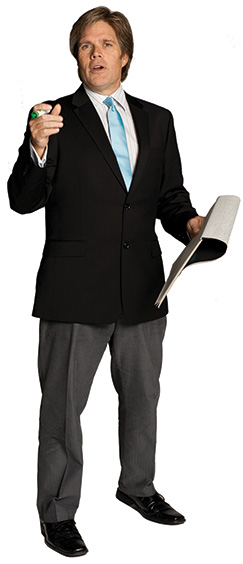December 6, 2013

Michael Gibson (Photo by Jonathan Reynolds)
How can you give an effective presentation?
It's something that nearly every employee has to do, and something many people hate: standing up in front of coworkers — or even worse, at a conference where you barely know anyone — and giving a presentation.
Anyone can learn to bury the butterflies in their stomach and give a stellar presentation, says Michael Gibson, associate professor of communication design.
Gibson teamed up with communication design and theatre alum Megan Mead ('10) to speak before 1,000 people at the 2013 South by Southwest Interactive Conference in Austin about the most effective ways to present ideas to small and large groups. The conference is a leading go-to venue for presenting innovative ideas.
Gibson offers the following advice to help others make their presentations confidently:
Remember the three P's
- Plan what to say. Think carefully about the structure of your presentation. Few can "wing it" successfully.
- Prepare yourself. Good presentations make clear arguments, not assertions. Present facts that prove points based on evidence.
- Practice speaking out loud in a quiet area. Speak to a chair or objects in the room and direct your gaze.
Focus on your audience
- Break down complex concepts to make them understandable. Give two or three "take-aways" that show why your idea is important.
- Create empathy about your idea so that audience members care about the idea and understand why they should care.
- Be engaging. Don't read directly from slides. Show enthusiasm.
Get physical
- Deep breathing exercises prior to the presentation can help calm you.
- Shake out your arms. Stand up.
- Walk around. Don't go from a sedentary position straight into a presentation.
- Tongue twisters prepare your mouth muscles. Repeat: "Buh, duh, fuh, duh, guh, duh" or "Toy boat, toy boat, toy boat."